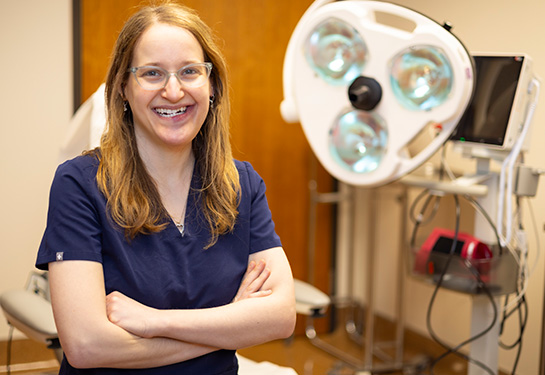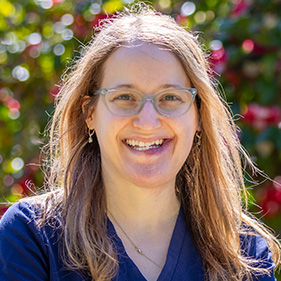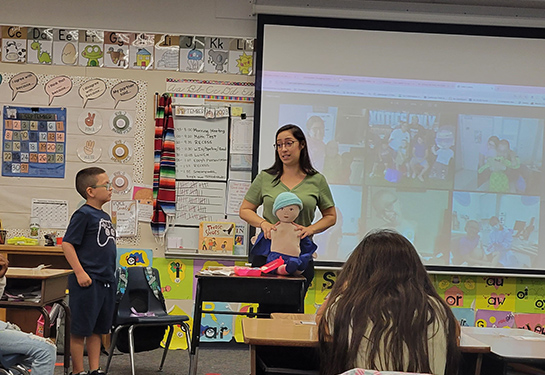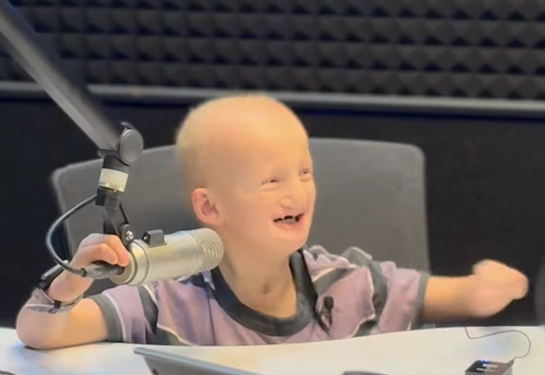How her birthmark set one dermatologist on a gratifying career path
Caitlin Peterman connects with and cares for people who have vascular anomalies
Vascular anomalies are a particular interest of dermatologist Caitlin Peterman. She was born with one herself, and the experience influenced her career choice. Vascular anomalies are growths or birthmarks consisting of blood vessels that developed abnormally.
Peterman recently joined the Department of Dermatology at UC Davis Health. Originally from Massachusetts, she did a fellowship in pediatric dermatology and is double board-certified in dermatology and pediatric dermatology. Peterman completed her dermatology residency at UC Davis Health. In this Q&A, she discusses her work treating children and adults with vascular anomalies.
Why did you choose to focus your work on vascular anomalies?

I was born with a capillary malformation on my face, also called a port wine birthmark because of its typical color. I began getting treatment at around 6 weeks old. Multiple times a year for most of my childhood, I would get laser treatments to lighten my birthmark and prevent potential complications. It was hard: As a kid, you don’t want to be different, and people will notice when it’s right on your face. I recognize how hard that can be, especially for my young patients, and how impactful it is to have somebody who understands what you’re going through.
How are vascular anomalies categorized, and how do they differ?
The major split is tumors versus malformations. The tumors are growths made of endothelial cells [cells that line blood vessels]. Most of these tumors are benign and tend not to be a problem. There are benign tumors can be problematic depending on their size and location, and rarely there are malignant vascular tumors.
Malformations are vessels that didn’t form properly. There are four major types: arterial, venous, capillary or lymphatic, and these can also present in combination. Some are evident from birth or shortly thereafter. Others, like some arteriovenous malformations, may not present until much later in life. Hormonal changes, like during puberty or pregnancy, can worsen these. And aging itself can lead to progression. An example is with capillary malformations, where you can develop blebs, or bubbles, of dilated capillaries on the skin surface that can bleed.
What are the most common types of vascular anomalies you deal with?
In babies, the thing I see the most are infantile hemangiomas. Those are benign tumors that develop within the first few weeks of life and grow until kids are about a year old. Then, interestingly, they go away on their own slowly over the next several years. For many of these, we can let them run their course. But if they’re in a location that could cause permanent physical distortion as they grow, like on the tip of the nose, or could cause functional impairment, like on the eyelid, they need to be treated. Also, some can be associated with internal findings. We like to evaluate all infantile hemangiomas to make sure there are no external or internal issues we need to worry about. The second most common vascular anomaly I see is the port wine birthmark.

What are the treatment options for vascular anomalies?
Infantile hemangiomas can be treated with a topical or oral beta blocker. Other vascular tumors may not need any treatment, or may require surgery, oral medication, chemotherapy or radiation.
For the capillary malformations, the main treatment is multiple sessions of pulsed dye laser. For lymphatic or venous malformations, first-line treatment is typically supportive care with compression and pain control. Sometimes, surgery can remove part or all of the malformed vessels. Sclerotherapy, where medical “glue” is injected into vessels to close them off, may be an option for some. We also have an increasing number of medications, such as sirolimus and alpelisib.
For kids with a capillary malformation, I can pull down my mask and say, look, I have the exact same thing. I can tell you exactly what this is like as a kid and as an adult, and it’s going to be OK.” —Caitlin Peterman, dermatologist
What kind of response do you get from parents when you tell them you have a birthmark?
Oh, it’s amazing. For kids with a capillary malformation, I can pull down my mask and say, look, I have the exact same thing. I can tell you exactly what this is like as a kid and as an adult, and it’s going to be OK. The parents often tell me it’s a huge relief that the doctor treating their child has the same thing and can provide insight. It’s really rewarding. Those are probably my favorite patients because it’s so personal for me.
Do you treat people of all ages?
I do. I love to see adults with vascular malformations because a lot of people who treat them are primarily in the pediatric realm and don’t really feel comfortable treating adults. These conditions are usually diagnosed and treated all throughout childhood, but these are lifelong conditions. I really wanted to help take care of adults who either didn’t get treatment as children or who still need treatment.
What excites you about your work right now?
I’m really interested in reaching out to rural communities. We have patients who drive four or five hours from outside Redding or Nevada to see us. We want to provide more access for communities that don’t have a pediatric dermatologist.





